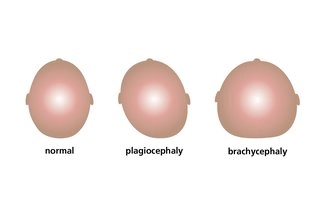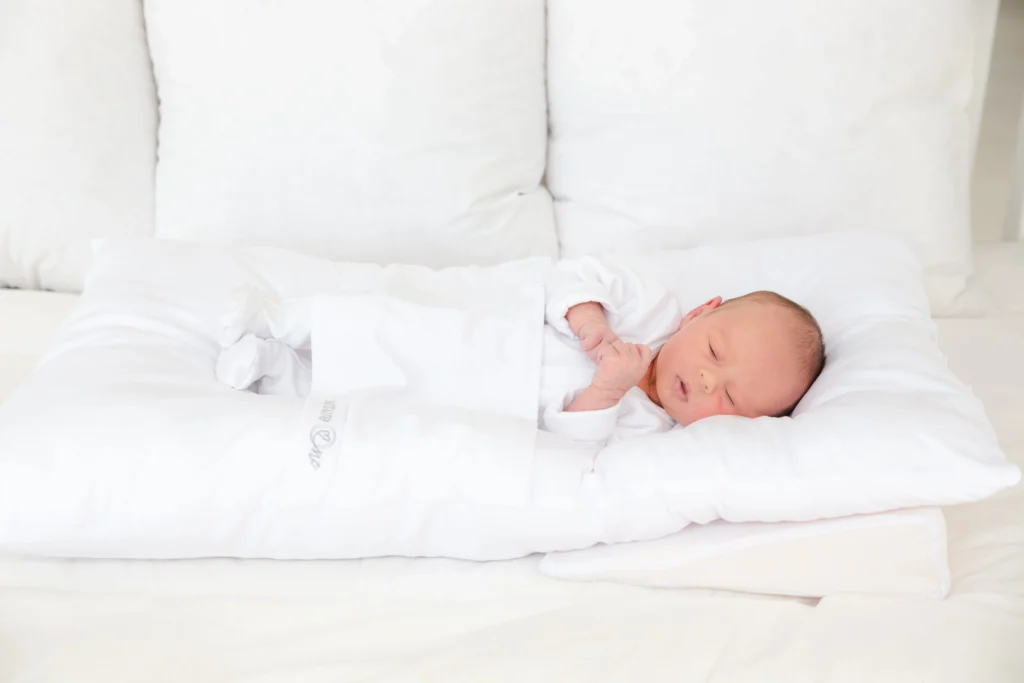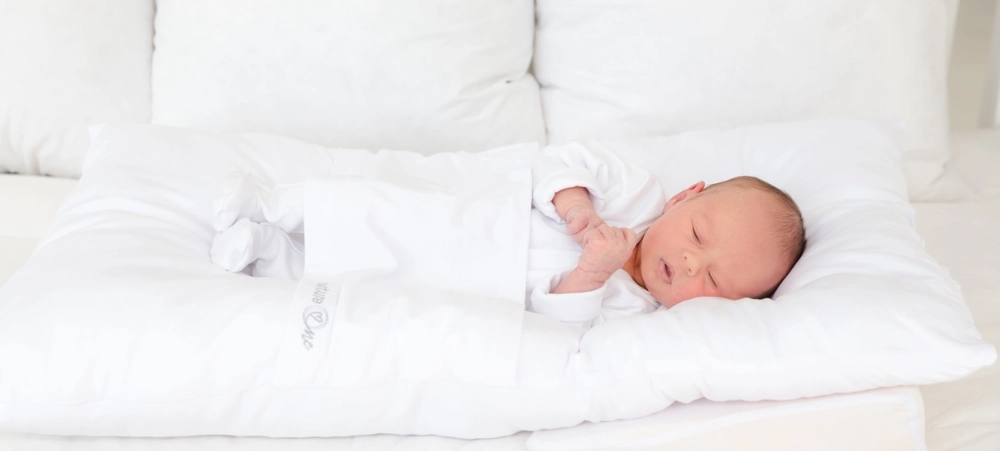Deformational, or positional, plagiocephaly is commonly known as flat head syndrome. It is a condition where a baby’s head has a flat spot or appears asymmetrical. It can be quite upsetting as parent; however, it is important to remember that it is not a serious health issue. Positional Plagiocephaly is not responsible for abnormal brain development or the onset of neurological problems. It is critical, though, to prevent skull deformity to avoid aesthetic and functional consequences. There are very effective methods of treatment available, of which you can introduce immediately, either to rectify your baby shape of his or her head or to prevent this from happening.
When your baby is born, their skull is made up of soft bony plates that can compress and overlap to fit through the narrow birth canal. This process is called moulding, and it can cause the baby’s head to have a slightly abnormal shape at first. However, within 24 to 36 hours after birth, the head usually becomes more symmetrical and egg-shaped. It’s important to know that this is normal and not a condition called plagiocephaly.
During the first year, your baby’s skull remains soft because their brain grows quickly, reaching about 85% of its adult size in that time. This softness makes your baby’s head flexible, especially in the first few months. If your baby spends a lot of time lying on their back in the same position, it can lead to flattening on one part of the skull.
Types of Flat Head Syndrome (according to the National Health Service of England)
Plagiocephaly can take two main forms:
- Plagiocephaly: This happens when one side of the head is flattened, leading to noticeable asymmetry. You might notice that one ear is misaligned, and the head may look parallelogram-shaped from above.
- Brachycephaly: This type involves flattening at the back of the head, causing it to widen and sometimes resulting in a protruding forehead.

Signs and Symptoms
Common signs of plagiocephaly include:
- Flat Spots: Noticeable flat areas on one side or the back of the head.
- Asymmetrical Features: One ear may appear pushed forward, and the cheek or brow on the flattened side might look more pronounced.
- Uneven Forehead: The forehead on the affected side may stick out slightly.
According to research done by the Cleaveland clinic, over 50% of babies may experience some degree of plagiocephaly in their first months. Many parents notice changes around six weeks of age. Flat head syndrome often develops from prolonged pressure on one area of the head, so it’s essential to keep an eye on your baby’s head shape and seek advice if you have concerns.
Reasons why this may happen include:
- sleeping on their back – the back of a baby’s head can become flattened as a result of always sleeping on their back on a hard mattress. However, this position is encouraged for lowering the risk of sudden infant death syndrome (SIDS) and adhering to the “back to sleep” campaign
- problems in the womb – pressure can be placed on a baby’s head before they’re born if they’re a bit squashed in the womb, or there’s a lack of amniotic fluid to cushion them
- being born prematurely – premature babies are more likely to develop a flattened head because their skull is softer when they’re born, and they may prefer to rest their head on one side at first as they’re not yet able to move their head themselves
- neck muscle tightness – this can prevent a baby turning their head a particular way, meaning one side of their head is placed under more pressure
Occasionally, a flattened head can be caused by the plates of the skull joining together too early. This is known as craniosynostosis.
For most infants, plagiocephaly isn’t a serious health issue and usually resolves on its own with simple interventions. However, severe cases can lead to lasting changes, making early identification and intervention important.
Treatment Options
If you notice signs of plagiocephaly, here are several effective strategies to consider:
- Repositioning Techniques: Change your baby’s position during sleep to relieve pressure on flat spots. Encourage them to turn their head to the opposite side while sleeping.
- Tummy Time: Encourage tummy time while your baby is awake. This helps strengthen their neck and shoulder muscles and reduces the time they spend lying on the back of their head.
- Physical Therapy: A peadiatric physical therapist can provide exercises to help improve head shape and strengthen/ lengthen and normalise tight neck muscles.
- Cranial Remolding Helmets: In more severe cases, a helmet may be recommended to help shape the skull as your baby grows.
Preventive Measures: To reduce the risk of plagiocephaly, here are some simple and effective steps you can take at home. These tips involve being mindful of your baby’s position, movement, and how you engage with them in your daily routine.
- Supportive Sleeping Cushions: Use supportive products and regularly change your baby’s position during sleep such as the nurtureOne nesting cushion.
- Encourage Head Movement: Engage your baby with toys that encourage them to look in different directions, allowing for free head movement.
- Vary Play Positions: Let your baby play in different positions to promote head rounding, including tummy time.
- Carry and Feed from Both Sides: Alternating the side you carry and feed your baby can help balance head pressure.

When to Seek Help
If you notice any of the following, consider consulting a healthcare professional:
- Early Flat Spots: If you see a flat spot developing by 6 to 8 weeks, start repositioning techniques. If the flatness doesn’t improve by 4 to 6 months, seek advice.
- Persistent Flatness: If a noticeable flat spot remains or worsens, consult your doctor or health visitor.
- Head Turning Preference: If your baby consistently turns their head to one side, it could lead to uneven pressure.
- Facial Asymmetry: If you notice one ear pushed forward or other asymmetrical features, it’s time for an assessment.
- Developmental Delays: If your baby shows delays in head control or reaching milestones, an assessment can help determine if these issues relate to plagiocephaly.
- Family History: If there’s a family history of craniofacial conditions or if your baby was born prematurely, consider seeking an assessment sooner.
Preventative methods for plagiocephaly are easy to use and highly recommended. If your baby has a flat or uneven head shape, starting early can lead to better and faster results because your baby is growing quickly. It’s best to begin treatment between 4 to 7 months, but you can continue effective intervention until your baby is 14 months old.
It’s important to change your baby’s position each time you put them down to sleep. The nurtureOne nest can help with this, as babies often settle into the same comfortable position. This cushion is designed with your baby’s safety in mind. Make sure to alternate the direction your baby’s head is lying each time you use it—first on their back, then to the right (half back, half side), and then to the left (half back, half side). You can adjust the cushion to support these positions. For more information, visit www.nurtureOne.co.za.
By following these steps you can avoid positional plagiocephaly. You have the power to help your baby thrive. By staying informed and proactive, you can make a positive impact on their health and well-being. Trust yourself and your instincts as a parent—your involvement is key to ensuring your baby’s healthy development.
The specially designed nurtureOne™ nesting cushions provide the same sense of calm and security that babies felt in the womb, assisting in sustaining good sleeping patterns.
- What is Plagiocephaly? - January 14, 2025
- Understanding Reflux in Babies - December 2, 2024
- Why are newborns soothed by being contained and touched? - November 5, 2024





